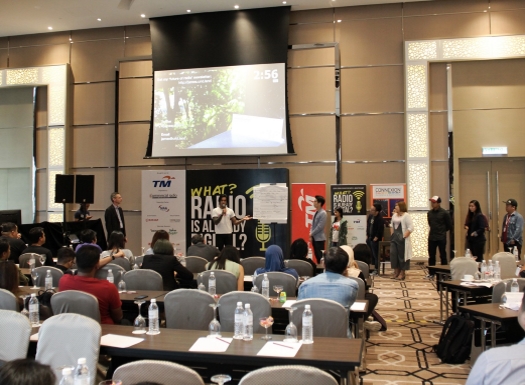Commercial Radio Malaysia (CRM) recently held its annual conference titled “What? Radio Is Already Digital?” to highlight GfK’s recent findings about the trends in Malaysian radio and discuss its future.
The event featured a panel of radio experts including Lee Risk, Commercial Director of GfK Asia, Seelan Paul, CEO of Media Prima, Jayaram Gopinath, Head of Astro Radio Digital, Erin Hwang Bin Bin, General Manager of Sales for Star Media, and the keynote speaker for the event was James Cridland, Radio Futurologist and award-winning copywriter who also contributes to AsiaRadioToday.
According to the research, 97.2% of Malaysians listen to radio, making it one of the largest platforms available to advertisers with the average listener clocking just over 2 hours of listening time per day.
Listeners aged 18 – 34 prefer to use newer forms of technology to listen to radio with 33.5 percent tuning in via their mobile/smart phones, as compared to the national average of 28.9 percent, highlighting a need for radio to evolve with the technology of the times.
With 70 percent of respondents said that they “can listen to radio anytime and anywhere” and 66 percent of them said that “radio keeps me company”, it is apparent that radio’s strength lies in its accessibility, and its role as a substitute for human company.
For 80 percent Malaysian listeners, radio advertising makes a brand more appealing, for 74 percent – more trustworthy, for 72 percent – more authentic and for 68 percent it increases loyalty.
Radio is also making the biggest inroads into digital media, with 42 percent of all radio listeners providing their feedback and comments on their preferred radio station’s social media platforms, compared to only 28 percent of all TV watchers engaging with a station’s associated social media platforms.
In his talk titled ‘Radio’s Future’, James Cridland said that the future of radio rests on three key points: Content, Technology and User Experience.
One example of this is pop-up radio – a radio network’s satellite stations that can broadcast more specific content without impinging on the main station’s regular music schedule. This gives radio stations more freedom to produce creative content, allowing them to do things such as broadcast crucial news updates in real-time, play artist-exclusive music. An example he shared was the case of Absolute Radio, where addition of sub-stations has doubled its total listenership volume between 2009 to 2015, allowing advertisers to buy twice the airtime as compared to before.
Cridland also stressed the importance of putting radio on as many different digital media platforms as possible to reach the largest number of people.
Existing creative solutions include rebroadcasting a show’s best content later in the day, playing content on-demand on the station’s website and recording shows as podcasts to be released on iTunes and downloaded at the user’s convenience.
There are also mobile apps in the market that not only broadcast radio stations, but go one step further in user customisation. For example, NPR’s radio app changes its songs and news stories based on the user’s preferences, which has been shown to increase user listening time by two-fold.
Radio’s future lies in diversifying into more platforms for an increasingly multiplatform world. In Norway, DAB+ Radio has overtaken FM radio in usage, prompting the Norwegian government to roll back FM radio and stop using it for good in 2017.

